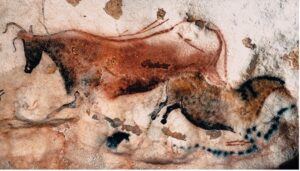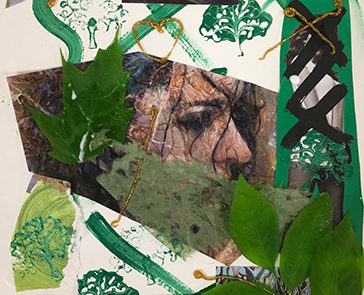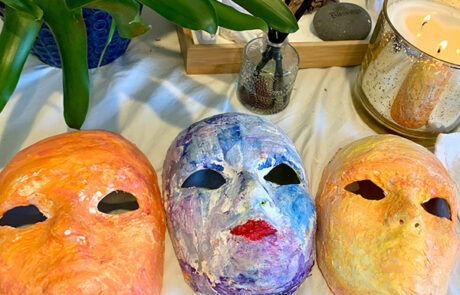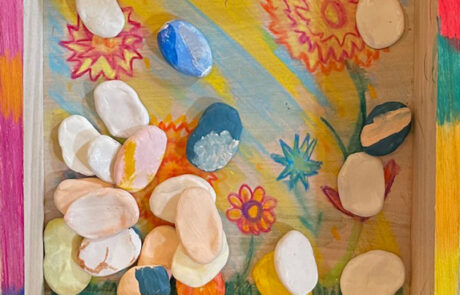
Detail, “Thesis: Gamete,” ©2023 Elizabeth Bryan Studio
“Those who flow as life flows know they need no other force.” Lao Tzu
Welcome. It is an honor to share Creativity as Contemplative Practice. This approach brings together the benefits of art-making, ritual and mindfulness, opening a door to our deepest knowing through creative expression and the beauty of the present moment.
Contemplative practice is a broad term that includes mindfulness, meditation, prayer, yoga and ritual, to name a few. It also includes any kind of artistic expression as well as time in nature. According to the Center for Contemplative Mind in Society, contemplative practice includes any activity that supports us in connecting with something greater than ourselves, and an awareness of own inner wisdom, that carries forward into our lives.
With roots in the wisdom traditions and world religions, more than 50 years of research has shown that contemplative practices can support positive mental health and emotional well-being, as well as reduced stress, anxiety, and depression. Contemplative practices help us tune into sensory experience and cultivate moment-to-moment awareness. They help us detach from outcomes, lifting up feelings like gratitude, compassion and empathy.

Lascaux Cave Painting, approximately 17,000 years old
Deeply rooted in human evolution, creativity has been expressed through early works like cave paintings that date back 64,000 years. Throughout history, creativity has been a valued path to personal insight and spiritual connection.
Today, the benefits of creative practice are well-known, beginning with a physical response that includes a, “cascade of endorphins, serotonin and dopamine, the brain chemicals that affect our well-being,” as well as increased feelings of joy and contentment. Combining creativity with contemplative practice supercharges these benefits, in the same way that diet and exercise work together.
Many of you may be thinking, “But I’m not creative; I can’t even draw a straight line.” After facilitating creativity programs for over two decades, and now, as an art therapist, I am here to share that we are all born creative; we’ve simply lost touch with this part of our being.
Research backs me up with studies pointing out that everyone is creative. Activities like gardening, cooking, sewing, and even navigating how we partner and parent, are all examples of creativity. In fact, creativity is believed to be essential to human development, and a vital component of a healthy and happy life. Further, the work we do in art therapy is not about the end result although it can be: it is about the benefits and insights that arise, and are cultivated by, engaging with the art materials and therapeutic process.
Both art therapy and creativity as contemplative practice are about letting go of the outcome: a carryover that parallels Buddhist meditation and can benefit much of our lives.
They are a place of non-judgement, where imagination and expression are free to roam as it did when we were children, before we began to care what others thought of what we made.

Hand-carved fossilized bluestone Angel Wings and Labyrinth – Bobby Jacobs
“Those who flow as life flows know they need no other force.” Lao Tzu
Welcome. It is an honor to share Creativity as Contemplative Practice. This approach brings together the benefits of art-making, ritual and mindfulness, opening a door to our deepest knowing through creative expression and the beauty of the present moment.

Detail, “Thesis: Gamete,” ©2023 Elizabeth Bryan Studio
Contemplative practice is a broad term that includes mindfulness, meditation, prayer, yoga and ritual, to name a few. It also includes any kind of artistic expression as well as time in nature. According to the Center for Contemplative Mind in Society, contemplative practice includes any activity that supports us in connecting with something greater than ourselves, and an awareness of own inner wisdom, that carries forward into our lives.
With roots in the wisdom traditions and world religions, more than 50 years of research has shown that contemplative practices can support positive mental health and emotional well-being, as well as reduced stress, anxiety, and depression. Contemplative practices help us tune into sensory experience and cultivate moment-to-moment awareness. They help us detach from outcomes, lifting up feelings like gratitude, compassion and empathy.

Lascaux Cave Painting, approximately 17,000 years old
Deeply rooted in human evolution, creativity has been expressed through early works like cave paintings that date back 64,000 years. Throughout history, creativity has been a valued path to personal insight and spiritual connection.
Today, the benefits of creative practice are well-known, beginning with a physical response that includes a, “cascade of endorphins, serotonin and dopamine, the brain chemicals that affect our well-being,” as well as increased feelings of joy and contentment. Combining creativity with contemplative practice supercharges these benefits, in the same way that diet and exercise work together.
Many of you may be thinking, “But I’m not creative; I can’t even draw a straight line.” After facilitating creativity programs for over two decades, and now, as an art therapist, I am here to share that we are all born creative; we’ve simply lost touch with this part of our being.
Research backs me up with studies pointing out that everyone is creative. Activities like gardening, cooking, sewing, and even navigating how we partner and parent, are all examples of creativity. In fact, creativity is believed to be essential to human development, and a vital component of a healthy and happy life. Further, the work we do in art therapy is not about the end result although it can be: it is about the benefits and insights that arise, and are cultivated by, engaging with the art materials and therapeutic process.
Both art therapy and creativity as contemplative practice are about letting go of the outcome: a carryover that parallels Buddhist meditation and can benefit much of our lives.
They are a place of non-judgement, where imagination and expression are free to roam as it did when we were children, before we began to care what others thought of what we made.

Hand-carved fossilized bluestone Angel Wings and Labyrinth – Bobby Jacobs
Creativity as Contemplative Practice is foundational to Transpersonal Art Therapy, which is defined by the drive towards spiritual growth through creative process. As the earliest practitioners of transpersonal art therapy, art therapist Michael Franklin and colleagues (2000) shared that a transpersonal approach combines artmaking with other contemplative practices to build a bridge to dimensions beyond personal vision, and as an alternate way to experience consciousness.
In his 2017 book, Expressive Pathways to the Self: Art as Contemplative Practice, Franklin describes artmaking as both ritual and a way to contemplate, where the process of artmaking holds sway over the final product. Amplifying this idea, he shares that flow in art and meditation cultivates introspective abilities for insight and self-discovery, in a similar way to contemplative practice.
It is my honor to share my work and life through a contemplative, transpersonal lens.
Namaste,




